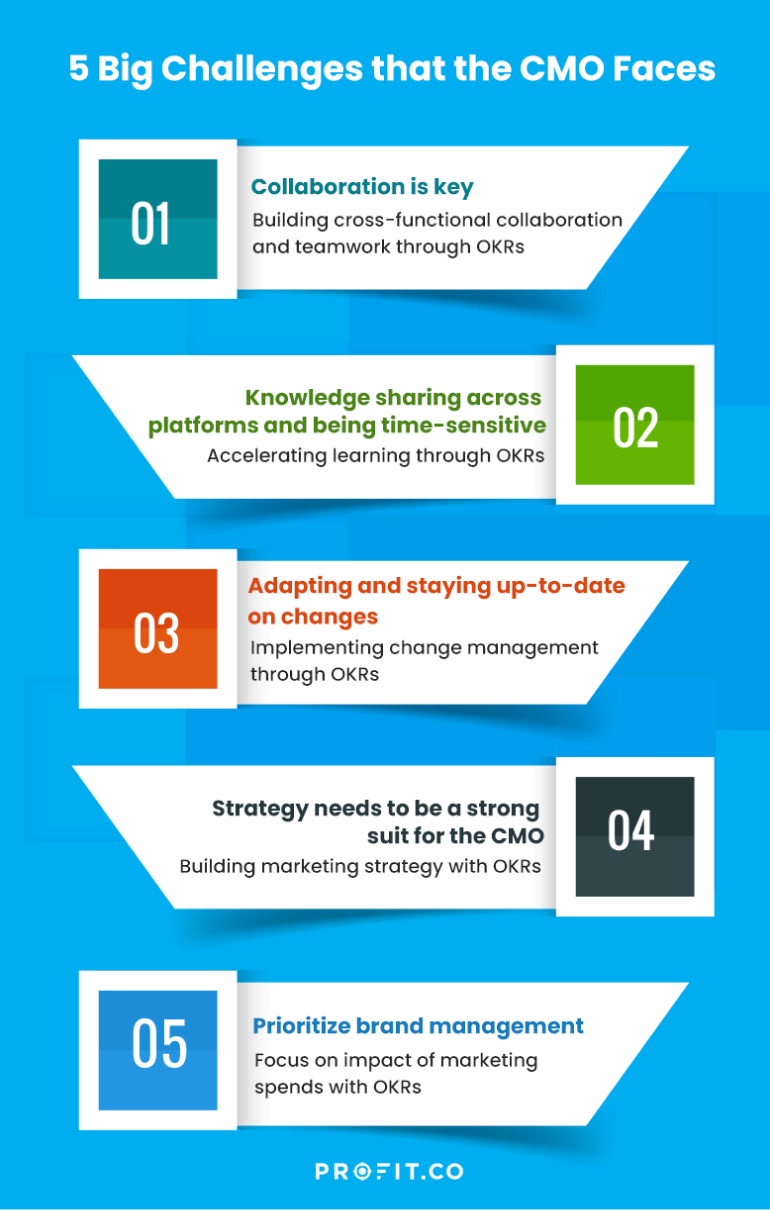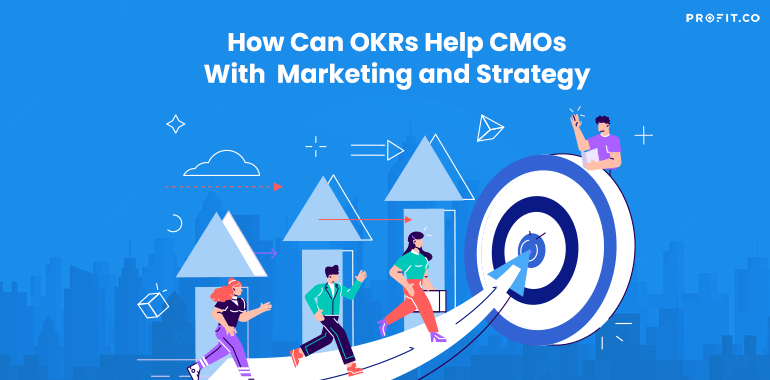The marketing arena has undergone significant evolution, mirroring the evolving role of the Chief Marketing Officer. While it has become increasingly exhilarating with the emergence of numerous new media and marketing channels, it has concurrently grown more intricate and demanding. The CMO’s role carries a heavy burden, as ensuring the organization’s sustained success presents a formidable challenge. As the challenges mount, the Objectives and Key Results (OKRs) framework emerge as a beacon of clarity, guiding marketing leaders toward desired outcomes with precision. But how exactly can OKRs amplify a CMO’s strategic prowess? Dive into this article to uncover the transformative potential of OKRs for modern marketing and strategy.
5 big challenges that the CMO faces
To start, let’s examine a compilation of obstacles that every CMO is likely to encounter. Here are the top five significant challenges
- Collaboration is key
- Knowledge across platforms and being time-sensitive
- Adapting to and staying up-to-date on changes
- Strategy needs to be a strong suit for the CMO
- Prioritize brand management
Marketing is about values. It’s a complicated and noisy world, and we’re not going to get a chance to get people to remember much about us. No company is. So we have to be really clear about what we want them to know about us.
1. Collaboration is key
Seamless collaboration should be intrinsic to the CMO’s skill set. They must grasp the intricacies of various departments to effectively guide the company’s progress, recognizing the interdependencies among all functions. Confident leadership of their team is imperative, and possessing expertise in diverse platforms and fostering cross-platform collaboration is a crucial skillset for success.
Building cross-functional collaboration and teamwork through OKRs
- The OKR framework facilitates the visibility of team goals and the organization’s objectives. OKR cultivates a culture of autonomy and encourages employees to set individual goals. OKR pushes individuals and teams to voluntarily reach out and collaborate with the leadership and other teams to meet their respective self-set goals.
- The chief marketing officer acts as an enabler who oversees the goal-setting and guides the marketing team members to connect with the right people and teams to meet their goals.
OKR examples
Objective: Enhance Cross-Platform Collaboration
Key results
- Successfully integrate all major tools and platforms used by the team by atleast 95%
- Prioritize the top 10 product features for Marketing
- Conduct 5 cross-platform collaboration workshops
- Generate weekly marketing goals based on the product Roadmap
2. Knowledge across platforms and being time-sensitive
Effective collaboration and knowledge sharing across various platforms are vital for organizational success. When a brand unveils a new campaign or product, it’s crucial to disseminate information across all relevant platforms. Access to domain-specific platform knowledge among stakeholders streamlines decision-making. Given the time-sensitive nature of new product launches and the constraints of a limited workday, prioritizing key channels and ensuring each department is led by a capable team leader can significantly enhance efficiency and timeliness. A leader who excels at quick thinking and efficient execution is a valuable asset to any organization.
Accelerating learning and through OKRs
- OKRs help measure and track the learning process and achieve the learning goals faster.
- Digital platforms evolve often, and marketing initiatives must be constantly modified and optimized accordingly. OKRs regularly help discover and share knowledge about the latest platform developments amongst team members. OKRs facilitate learning/upgrading quickly.
- OKRs help rapidly adopt emerging best practices that help maintain a marketing edge.

OKR examples
Objective: Upgrade the team on the latest industry developments and best practices
Key results
- Achieve a 100% completion rate for the technical development program
- Attend atleast one webinar every month on trending topics
- Increase the ROI of the Development program from 80% to 110%
3. Adapting to and staying up-to-date on changes
In an ever-evolving marketing landscape, the emergence of new channels is a constant. Adapting to these changes is one aspect, but staying abreast of these developments is another challenge altogether. Staying informed demands continuous effort, self-directed learning, and rigorous testing.
CMOs are in a perpetual quest to ensure their teams remain well-versed in the latest changes, comprehend their current implications on the business, and devise strategies for future handling. CMOs bear the responsibility of ensuring department heads are apprised of these transformations, effectively communicating this knowledge to their teams, and providing the necessary support and tools for adaptation. The OKR adoption serves as a time-proven methodology to implement strategies like change management within an organization.
A creative mindset serves as the driving force behind adaptability. Letting go of conventional approaches and embracing the new, displaying courage, and thinking innovatively in response to shifting market dynamics are indispensable skills for CMOs.
Implementing change management through OKRs
- OKRs help your team to quickly adapt to the latest changes in the marketing landscape through alignment.
- Since individuals’ contributions achieve team OKRs, a lack of uniform alignment can bring out the varying levels of goal achievement, thus highlighting the need for change uniformly across the team. Individual OKRs can also be used to implement change management. OKRs process encourages weekly reviews helping individuals to adapt to the changes.
- OKRs help you track the rate of adaptation to change and accelerate the change process.
OKR examples
Objective: Integrate the latest SEO practices within the content marketing team’s workflow.
Key results
- Ensure that 100% of the team completes Technical SEO certification
- Increase the utilization of targeted keywords in content from 50% to 75%
- Conduct a comprehensive SEO audit of our top-performing content pieces atleast once in 2 weeks
4. Strategy needs to be a strong suit for the CMO
The CMO should excel in strategy to the extent that they can envision the company’s future trajectory. Their proficiency should extend to formulating a long-term vision that involves assessing the present market dynamics and emerging trends, and then strategically applying these insights to propel the company’s growth and success.
- OKR, with its cascading flow of strategic choices and objectives from top to bottom, lets you formulate a marketing strategy in line with the organizational objectives and strategy.
- Marketing strategies always aim at the long-term benefits. For instance, in social media, you cannot create a reach, no matter how much content you post every day, without getting enough followers in the first place, which happens only over a period of time with careful implementation of a marketing strategy. Marketing OKRs help you put in a sustained effort and attain strategic success by ensuring continuity in long-term goals and creating the desired impact, which pays dividends over some time.
- OKRs let you constantly measure and verify the effectiveness of marketing strategy.
OKR examples
Objective: Build a High-Quality Inbound Lead Pipeline
Key results
- Increase product Inquiries & signup/week from our website from 400 to 500
- Increase Request per week from our website from 30 to 45
- Increase MQL from 50% to 60% for leads generated through websites
Want to get started on an intuitive and agile OKR software today?
5. Prioritize brand management
A CMO must demonstrate excellence across various domains such as strategy development, fostering cross-departmental collaboration, embracing adaptability in the face of change, and consistently delivering measurable ROI. This role demands robust business and commercial acumen, efficient management of diverse assets and resources, and a keen awareness of consumer sentiment—a pivotal factor that shapes crucial business and brand decisions.
- Lead generation and sales conversion through every marketing activity can be tracked. Calculate the return on investment for every initiative to understand the impact and recalibrate.
- OKR helps to quickly identify what works and what does not and rapidly align the team towards successful practices.
- OKR lets you discontinue marketing initiatives that do not bring the desired ROI and optimize marketing spending.
OKR examples
Objective:Maximize ROI from product launch digital ad campaign
Key results
- Increase email open rates in the email campaign for the new leads from 30% to 40% by the second week
- Increase conversion rate from 15% to 20% from the digital campaigns
In Conclusion
A CMO has many responsibilities, and the role is one of the most challenging with the constantly changing market dynamics. The CMO must be able to don many hats at once they need to be strategically inclined, be a good communicator, not ever take their eyes off the ROI, and be able to adapt to change, to just name a few.

